After Isco’s goal gave Real Madrid a 1-0 lead, the catastrophic final 15 minutes of the first leg saw Real Madrid concede two-goal to Manchester City and Sergio Ramos sent off. Two prolonged absences and a crammed league conclusion later, we return to UEFA Champions League play.
Now, nearly six months later, this spectacle reaches its climax. Manchester City are heavy favourites to advance, but, if the UEFA Champions League has taught us anything over the past decade, it’s that you should expect the unexpected.
In this tactical analysis, we’ll focus on the match from Real Madrid’s perspective. The objective of this tactical preview is to highlight realistic tactics Real Madrid can implement to overturn the deficit and claim a spot in the quarterfinals at City’s expense.
Predicted lineups
Manchester City’s predicted lineup (4-3-3) – Ederson; Kyle Walker, Fernandinho, Aymeric Laporte, João Cancelo; Rodri, İlkay Gündoğan, Kevin De Bruyne; Riyad Mahrez, Gabriel Jesus, Raheem Sterling
Pep Guardiola sends his Cityzens out in a 4-3-3, opting for a double pivot in midfield. This is a common tactic for City’s matches against top opponents, which is also a red flag for a tactical surprise. City pressed well in the first leg with Bernardo Silva highly engaged in the high press, but he looks likely to start on the bench. To start, look for Rodri and Gündoğan to join De Bruyne in midfield.
Ederson will surely start in goal with Walker and Cancelo as his outside-backs and Laporte at centre-back. Those are the sure starters. Nicolás Otamendi and Eric García are also in contention for that final spot on the backline, but the Argentinian’s erratic play and the Spaniard’s youth are concerns. Rounding out the formation, expect Mahrez, Jesus and Sterling from right to left.
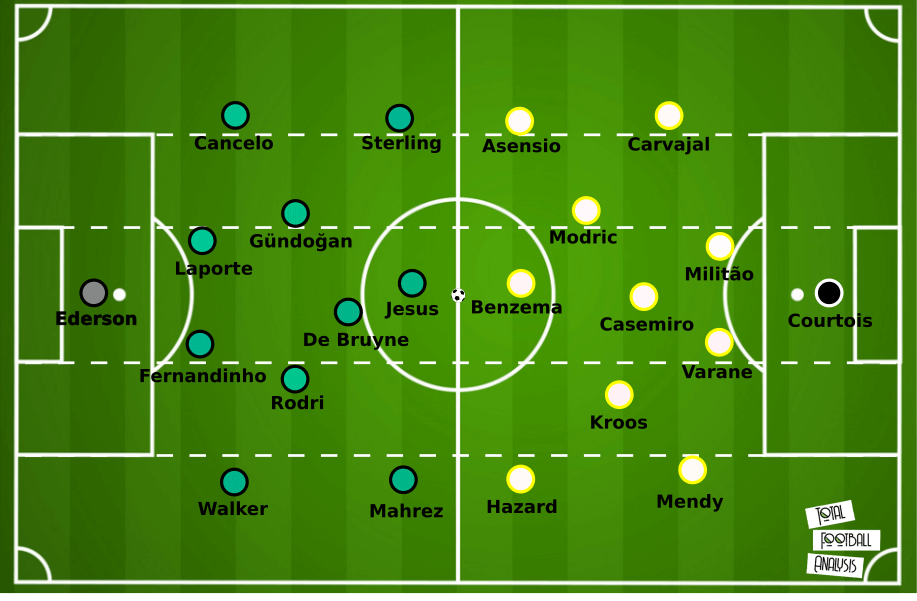
Real Madrid’s predicted lineup (4-3-3) – Thibaut Courtois; Dani Carvajal, Éder Militão, Raphaël Varane, Ferland Mendy; Casemiro, Toni Kroos, Luka Modrić; Marco Asensio, Karim Benzema, Eden Hazard
Zinedine Zidane has many options to choose from, both in terms of formation and starting XI, but his preferred 4-3-3 is likeliest. The alternative is a 4-4-2 will a diamond midfield, likely featuring Isco or Federico Valverde as the fourth mid, but that set up didn’t bear fruit in the first leg and Madrid need at least two goals.
Courtois starts in goal for Madrid, supported by a back four of Carvajal, Militão, Varane and Mendy, who looks likely to start over Marcelo as the Brazilian returns from another injury. In midfield, Casemiro is a given, Zidane rights his first leg mistake by starting Kroos and starts a rejuvenated Modrić as the right-centre midfielder. Valverde could also slot into that right-centre role, but Madrid need someone to aid progression and the Croatian is both more press resistant and a better distributor. Asensio, Benzema and Hazard played together in an intrasquad friendly and look like the leading candidates to start. The one issue is Hazard’s health, which is par for his season. MARCA reports that Hazard’s ankle remains a stumbling block, so the Belgian is gradually moving closer to the bench. If he’s unable to play the full 90 minutes, expect Vinícius Júnior start for Real Madrid in his stead.
Real Madrid must pick apart City’s high press
A tactical given when playing against a Guardiola coached side is the need to play through, around or over the high press. Both clubs found it difficult to beat the other’s high press in the first leg, though both teams go about it differently. Studying City’s match film, especially when the side uses a double pivot, the high press frequently became stretched as the City players chased.
In the first leg, Madrid’s compact 4-4-2 attacking shape gave Zidane the rest defence he wanted, but it also simplified Manchester City’s transition to defence. With little ground to cover from attack to defence, City was able to effectively press Madrid. While a sound rest defence is important, EPL’s top sides have shown offered a blueprint for beating the high press.
Rather than overloading the midfield with a diamond, a 4-3-3 will give Zidane’s side more outlets higher up the pitch and pin back City’s outside-backs and midfield. With City utilising the double pivot, that leaves four players in naturally high positions, disconnecting them from the deeper players. Since City engage in a zone oriented high press, they often leave large gaps between the lines, allowing the opposition’s midfielders to offer an outlet.
In the recent match against Chelsea, we saw the Blues attempt to play out from the back, encouraging De Bruyne and the forwards to continuously move higher up the pitch in pursuit of the ball. In the image below, Chelsea start the press with a really nice structure. The only ways out of pressure are back to Kepa Arrizabalaga or a hit-and-hope ball forward.
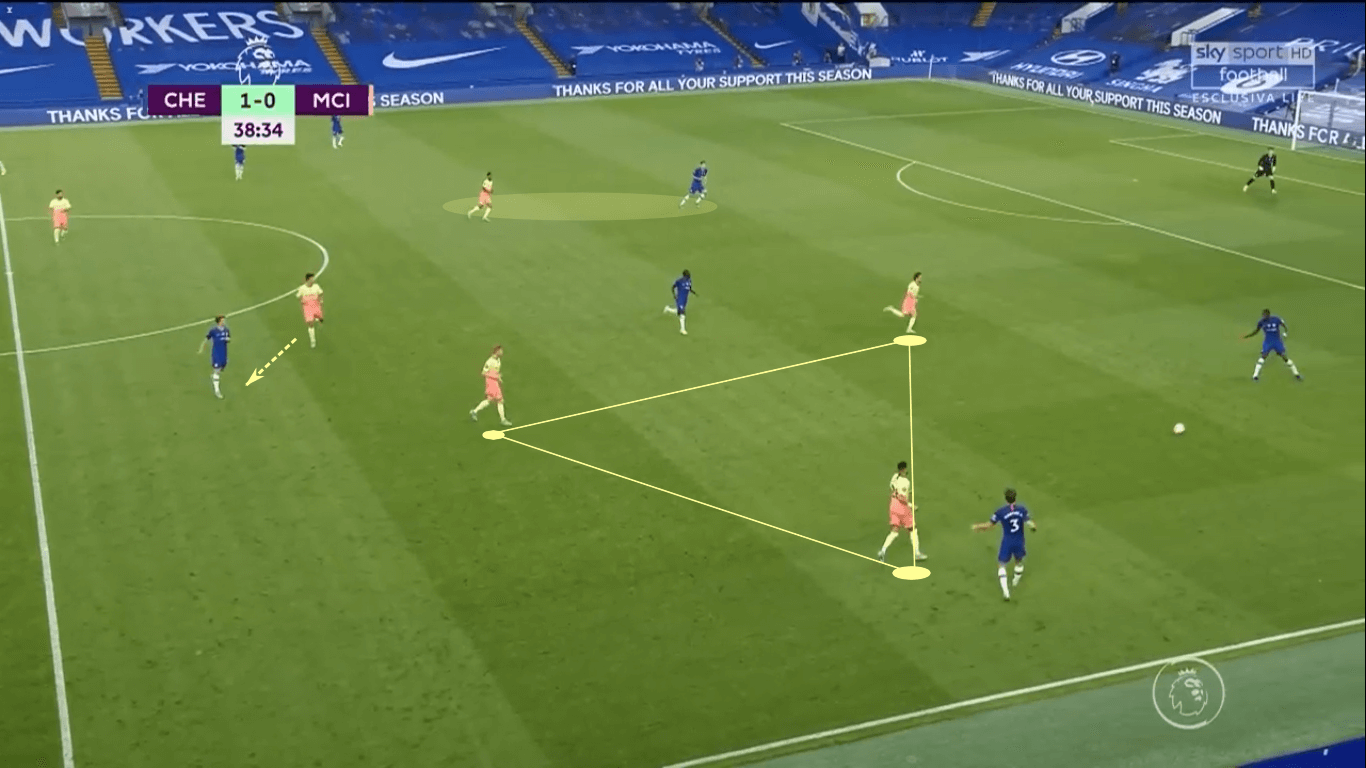
Antonio Rüdiger calmly played back to Kepa, then moved wide to receive again. With Bernardo caught between the two players, City was slow to round out their shape. The diamond allows the return pass to Rüdiger, who then plays N’Golo Kanté, who navigates that space so well on the play.
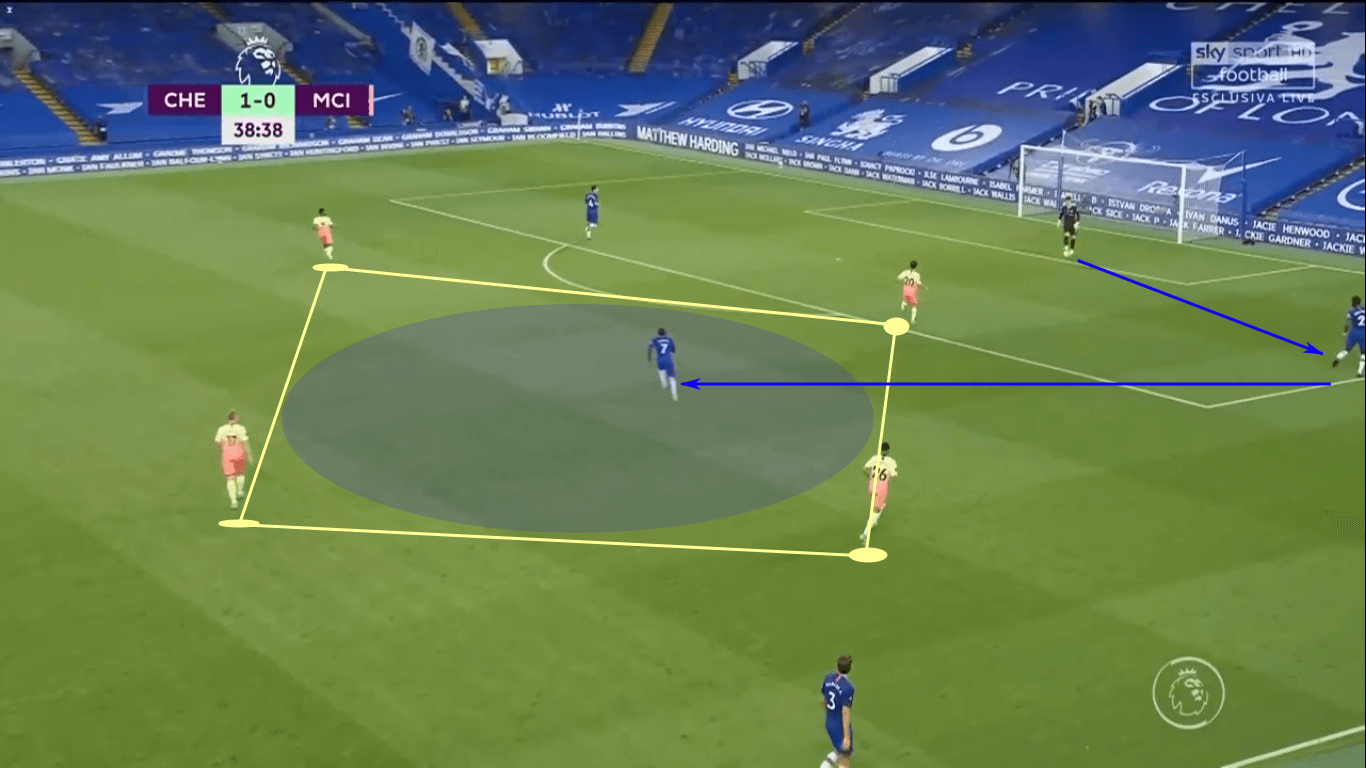
Casemiro, Kroos and Modrić will have to learn from Kanté’s example. It’s especially important for Kroos to locate and fill open pockets of space. With his ability to progress play, it’s vital that’s always searching for enough space to unleash his passing range. If City wants to use a high press, his press resistance and playmaking from deep can help Real Madrid break the first lines of pressure.
Once Real Madrid bypasses those first four City players, the match will open up. As City’s first wave of pressure is beat, it’s common to see them overcommit numbers near the ball without applying adequate pressure on the ball carrier. The far-sided outside back is typically the widest of the Manchester City 11 and, as you can see in the image below, Walker is in the vertical middle of the pitch. Narrow as they are, City gifts Willian an easy switch of play to the onrushing Marcos Alonso.
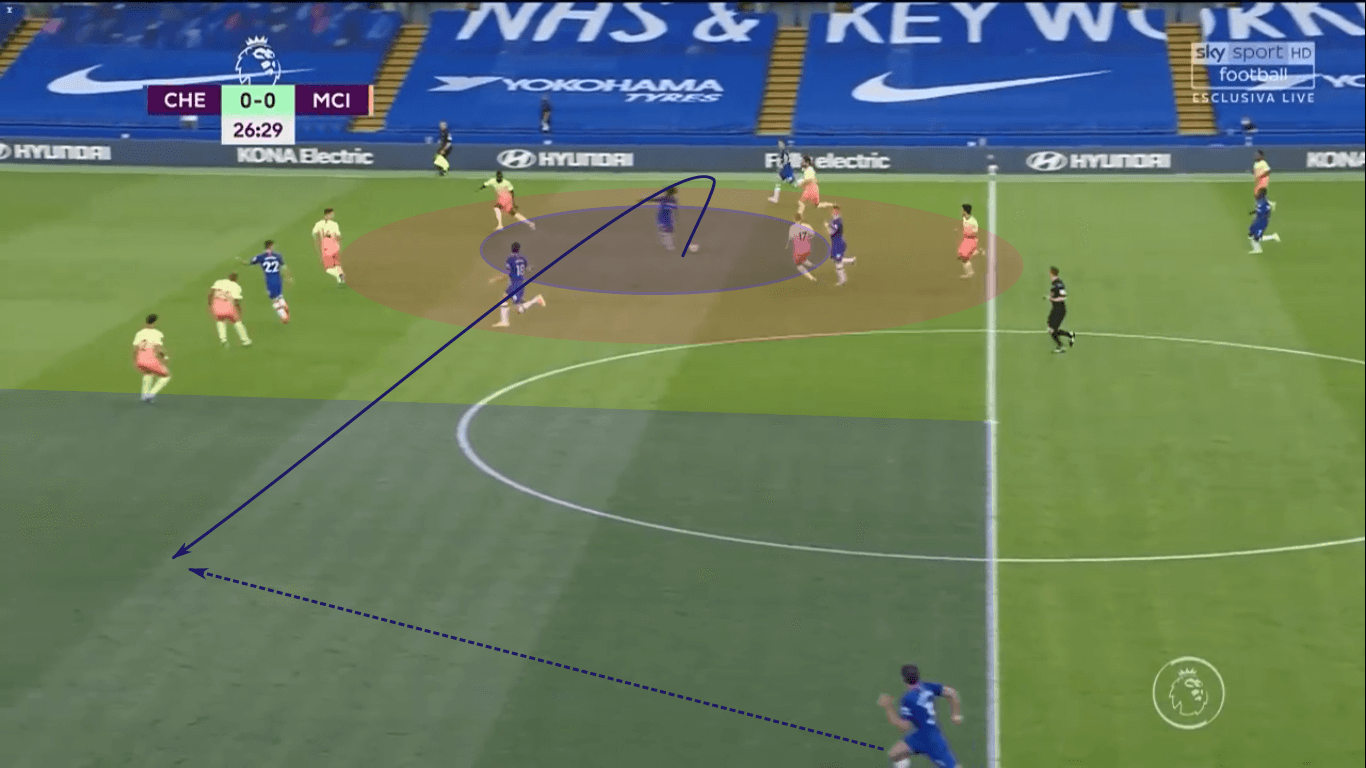
One of the other points worth mentioning is that Willian, even in the midst of City’s defensive imbalance, still managed to find a pocket of space for his distribution. Within the red circle, Manchester City enjoyed a 5v4 against Chelsea. However, with Benjamin Mendy dropping off on the play, that pocket emerged. You could say this aggressive team pressing tactic failed because the players carrying it out were not aggressive in their pressure.
Real Madrid’s highest players enjoy dropping between the lines to receive. If those movements are also coordinated with far-sided runs into open space and a near-sided forward running behind the lines to create space, Real Madrid should have a lot of success in progression through switches of play.
Attack City through half space and wing superiorities
With both teams a bit tentative in the first leg, I don’t think we saw either team hit peak performance. Rather, it was a cagey affair with each side trying to solve the problems presented by the other. While three goals were scored and each team had a couple of other quality chances, it was each team’s mistakes that produced the best chances.
Second legs tend to be more open as the result is decisive in the tie. With manche heading to Manchester staring at a 2-1 deficit, there’s a sense in the football world that this tie is City’s to lose. Oddsmakers list Manchester City as the heavy favourites to advance, so all the pressure is on them. Aside from the obvious psychological edge that gives Madrid, especially given Pep’s recent knockout stage results and City’s seven losses in 12 matches against the EPL’s top seven, this frees Madrid to play more freely.
Recognising Pep’s preference for the double pivot against top-class opposition, breaking that first wave of pressure, as mentioned above, is critical. However, once that first wave is beat, Real Madrid has to identify the best qualitative, quantitative and spatial attacking opportunities.
Since City are likely to have more possession, we’ll take this analysis a step back and look at City’s rest defence. When in possession with a double pivot, City’s left-back will provide width high up the pitch. If Guardiola wants his side to play more conservatively, Walker will linger behind to provide depth and stretch the opposition’s defence. Since Real Madrid aren’t likely to drop off as much as Chelsea, this option seems less likely, but it’s something the La Liga champions must prepare to defend.
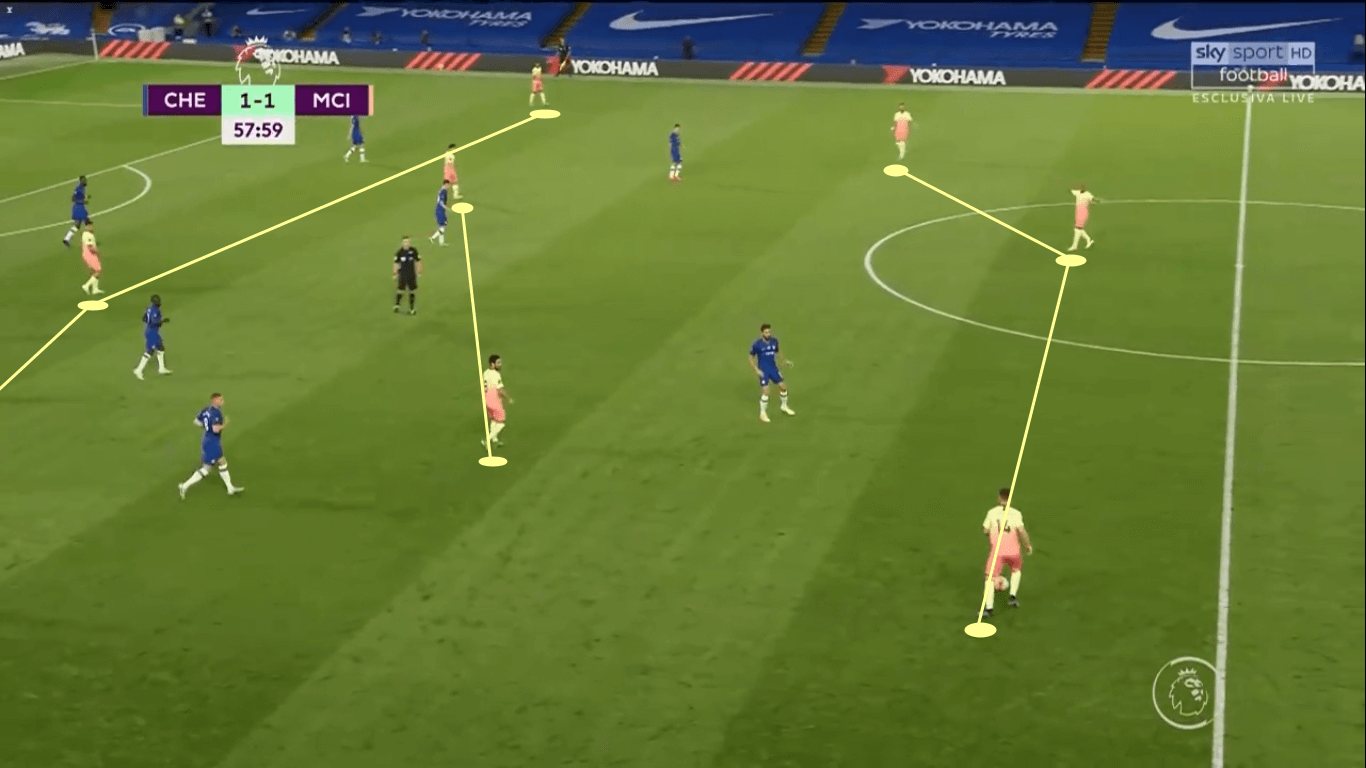
If City approaches the match this way, those two holding midfielders have more leeway to move about the central channel. With so few players committed to the middle, Real Madrid have obvious outlets to Benzema and a narrowly positioned Hazard at their disposal. If Vinícius gets the start in place of Hazard, Asensio is the more likely of the two to take up a narrow position in defence.
What if Manchester City elects to move both outside-backs high up the pitch? We’ll cover that tactic from Real Madrid’s defensive perspective shortly, but, in terms of attacking opportunities, expect the centre-backs and holding mids to form a square in the middle of the pitch. As space in the middle decreases, look for Madrid to target the wide forwards in the wings or half spaces.
Now, in an open possession, Madrid must prepare for the high press and City’s middle block. If Manchester City settle’s into the middle block, look for the same 4-4-2 that we saw in the first leg. As you can see in the image below, City does concede space between the lines, so there is an opportunity for the simple up, back and through pattern.
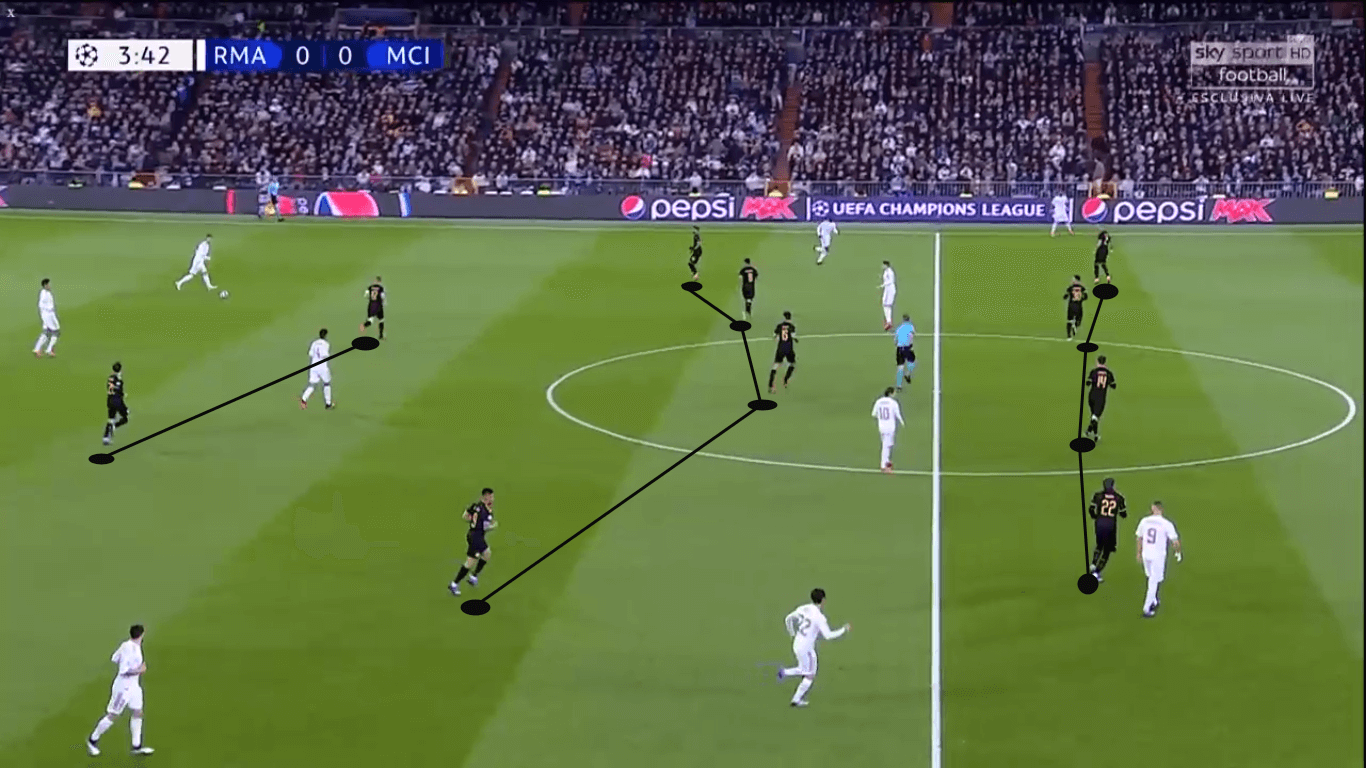
However, if the split pass isn’t on and Los Blancos are denied quick progression, the spotlight will turn to Kroos. One of the keys to Real’s attack is creating space for Kroos against the middle block. His ability to pull himself out of the play, allowing defenders to chase the ball or stick to their team’s defensive shape is excellent.
Much like Isco in the image below, Kroos must drop outside of City’s press, finding a pocket of space that will allow him to receive with his body oriented to see as much of the pitch as possible. Since Kroos is a right-footed player who operates as a regista in the left half space, he positions himself with the intention of free up the line breaking pass. The German’s vision is a key element of his side’s attack as he has both the awareness of movements higher up the pitch and the ability to hit runners.
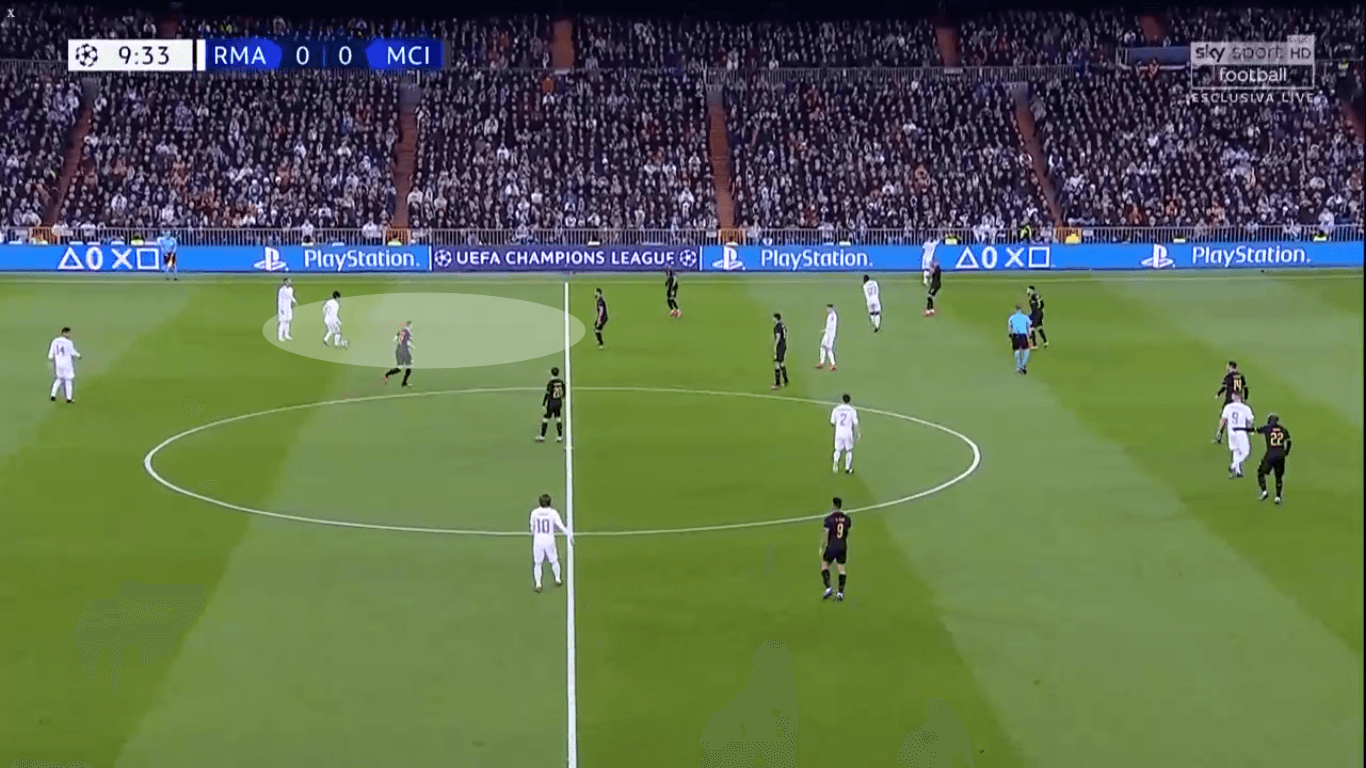
Sitting Kroos for the first leg really hurt the attack. His range, consistent presence in the left half space and ability to dictate tempo were sorely missed. However, he looks set to start in this match, which should lead to more scoring opportunities for Madrid.
As Kroos receives in the left half space, the wide overload of Hazard and Benzema, with help from Mendy, can help Madrid unlock this City defence. As makes his checks into the half space, keep an eye on the City defenders. If the centre-back goes with Benz, does the rest of the line become more compact? If not, is there a running lane for Hazard to get behind the defence?
If Vinícius Júnior starts instead of Hazard, the young Brazilian has better pace to get behind the line, but his recognition of opportunities and chemistry with Benzema are nowhere near the level of Hazard. If the Belgian isn’t able to start, look for more isolation against Walker than interchanges with Benzema.
In our best-case scenario, Hazard starts and plays the full 90 minutes. His movement between the wing and central channel is disorienting to opposing defences, creating freer lanes to goal for both himself and Benzema. With the left-back providing width, Hazard and Benz will stay closely connected in the half space and central channel in order to work off of each other. In this example against Villarreal, Hazard receives in a wide area, then plays negative. Upon releasing the ball, he then transfers command of the wing to Mendy by moving centrally. Benz pushes higher and Hazard enters the newly vacated space while Rodrygo moves wider and deep.
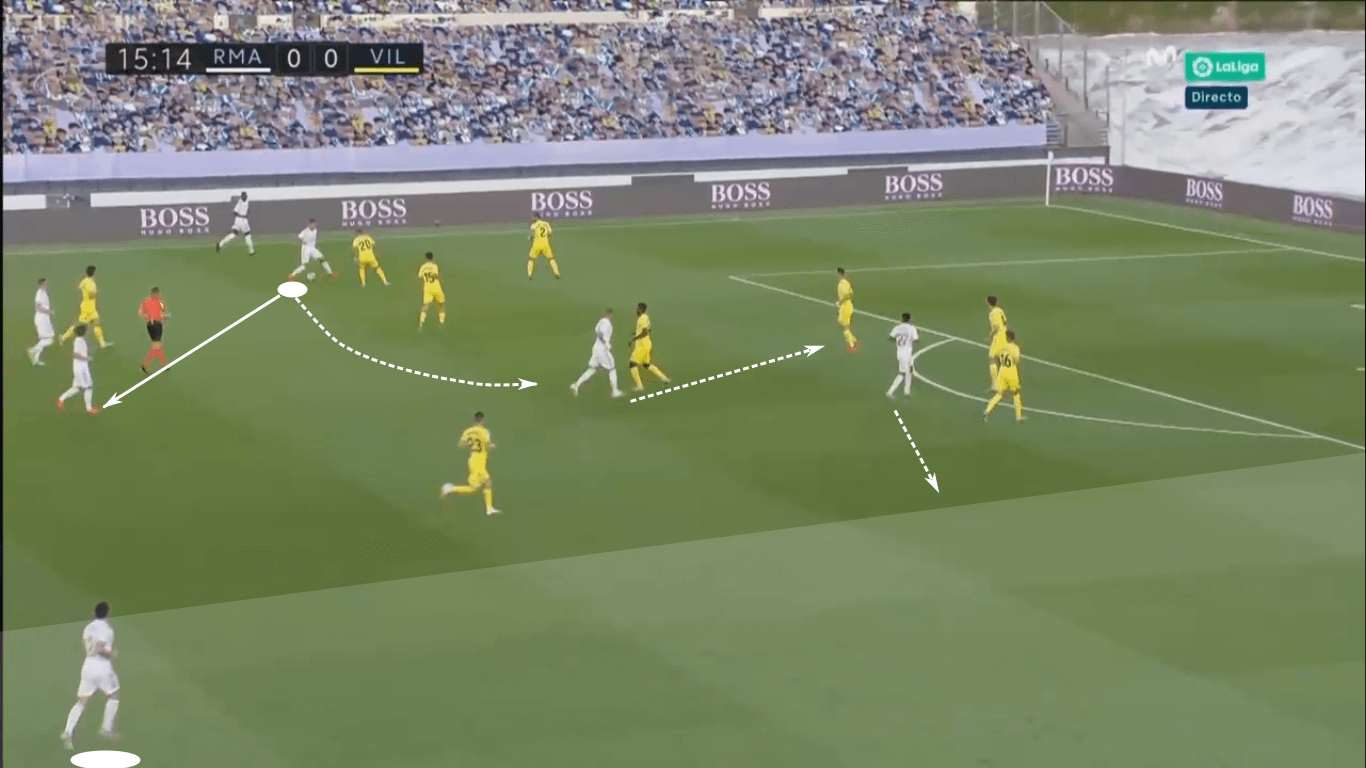
With Kroos in position to create from the half space and Modrić offering a central option, the three Madrid forwards pushed higher to pin the defence back. One option is the early cross into the box, another is that lateral pass to Modrić. If the latter, Modrić can then drive at the backline or complete the switch of play to Carvajal.
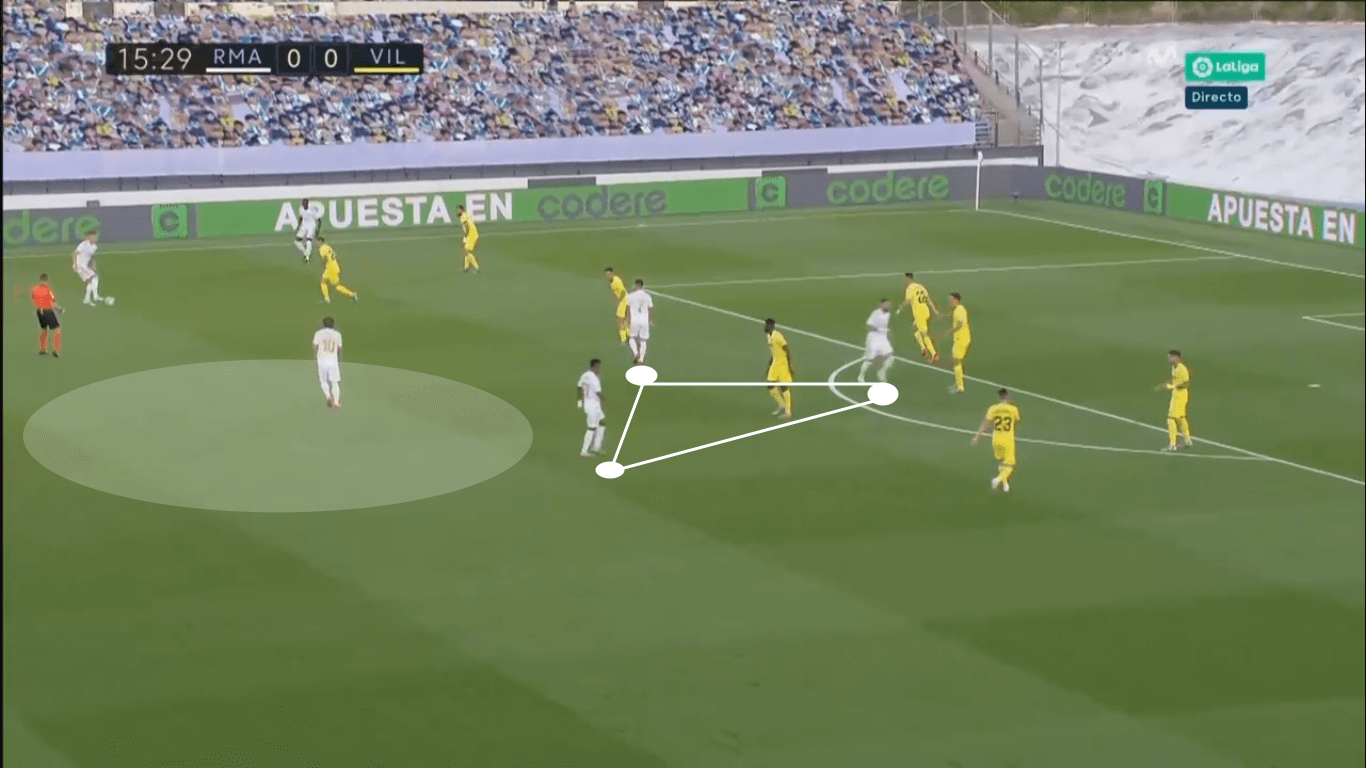
Real Madrid’s right side is less emphasised during that initial attack on the opposition, but the combination of Asensio, Modrić and Carvajal give Real Madrid an attacking trio that can overwhelm Manchester City’s left side. Additionally, as Madrid overload the wings and half spaces, the City pivots will move into wider areas in response. Use of width can help Madrid unlock this City side, letting their defensive imbalances come back to haunt them.
Stick with the man-marking high press
Ederson is widely regarded as one of the top distributors among the world’s goalkeepers. 70 metres onto the laces of a teammate isn’t beyond the realm of possibility. That said, he looked uncomfortable playing against Madrid’s man-marking high press in the first leg. Of the 11 long passes he attempted, only five reached his target. Of those passing attempts, three targeted a teammate in the final third, but only one of those passes was completed.
Fernandinho and Laporte are also excellent passers, but the combination of those two and Otamendi struggled to play out of pressure, especially when longing to play long to beat the press. For the match, City completed 24 of 38 long passes, good for a 63.16% success rate. That percentage is slightly below their UEFA Champions League average and below Madrid’s 66% completion rate. Forcing City to play long by man-marking all the short and intermediate-range outlets presents a big opportunity for Los Blancos. You’ll recall the Madrid goal came off of a botched attempt to play out of the back. This City defence will turn the ball over against top opposition.
Going back to the Chelsea match, we again have that blueprint of a successful high press. With the two pivots dropping deep and linking up with the centre-backs, Ederson had no immediate options. His two outside-backs were high up the pitch offering width and the four highest players were more central, provoking Ederson to try for his central targets.
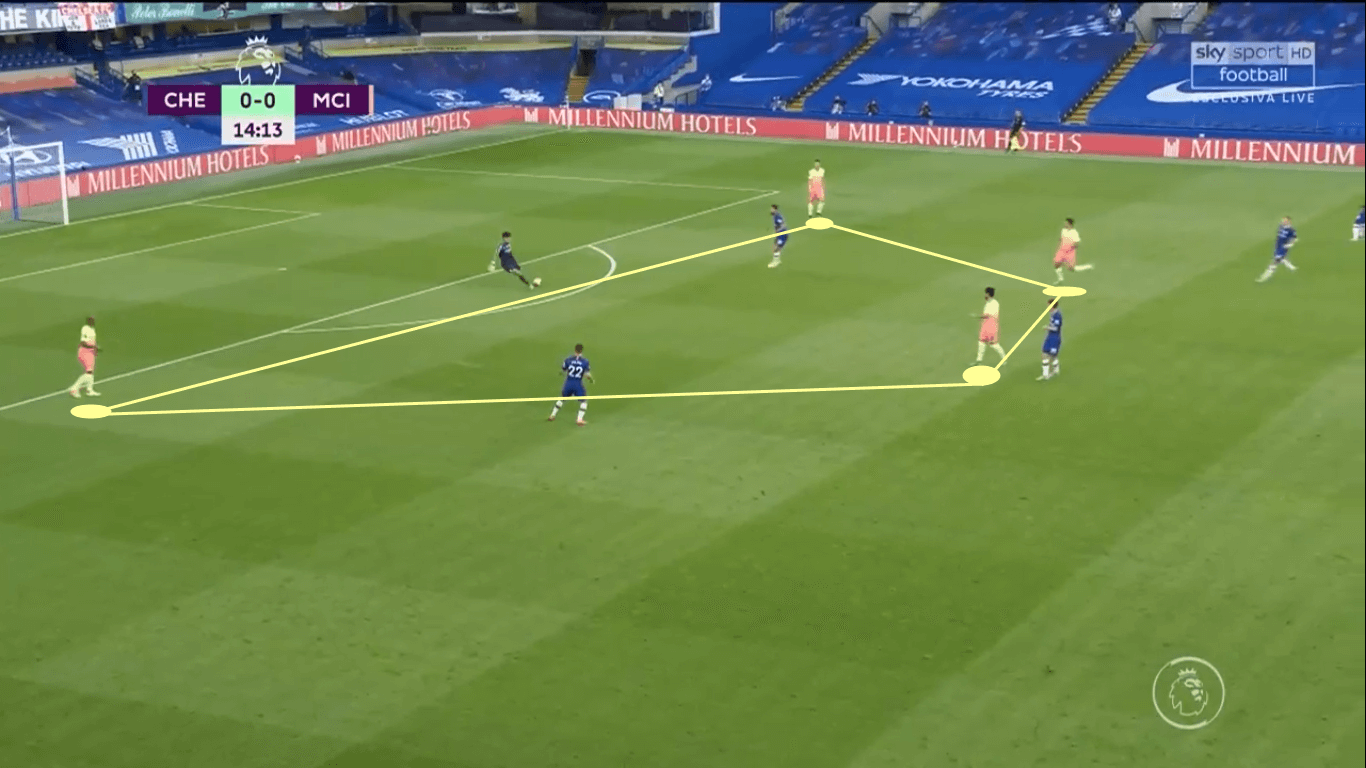
Minutes later, City’s build-up reached midfield. The image below gives us a really nice idea of what City’s attacking structure looks like if they beat the high press. The deep central square is maintained, the outside-backs provide width and the four highest players coordinate their movements, in this case with an asymmetric shape shifted towards the left.
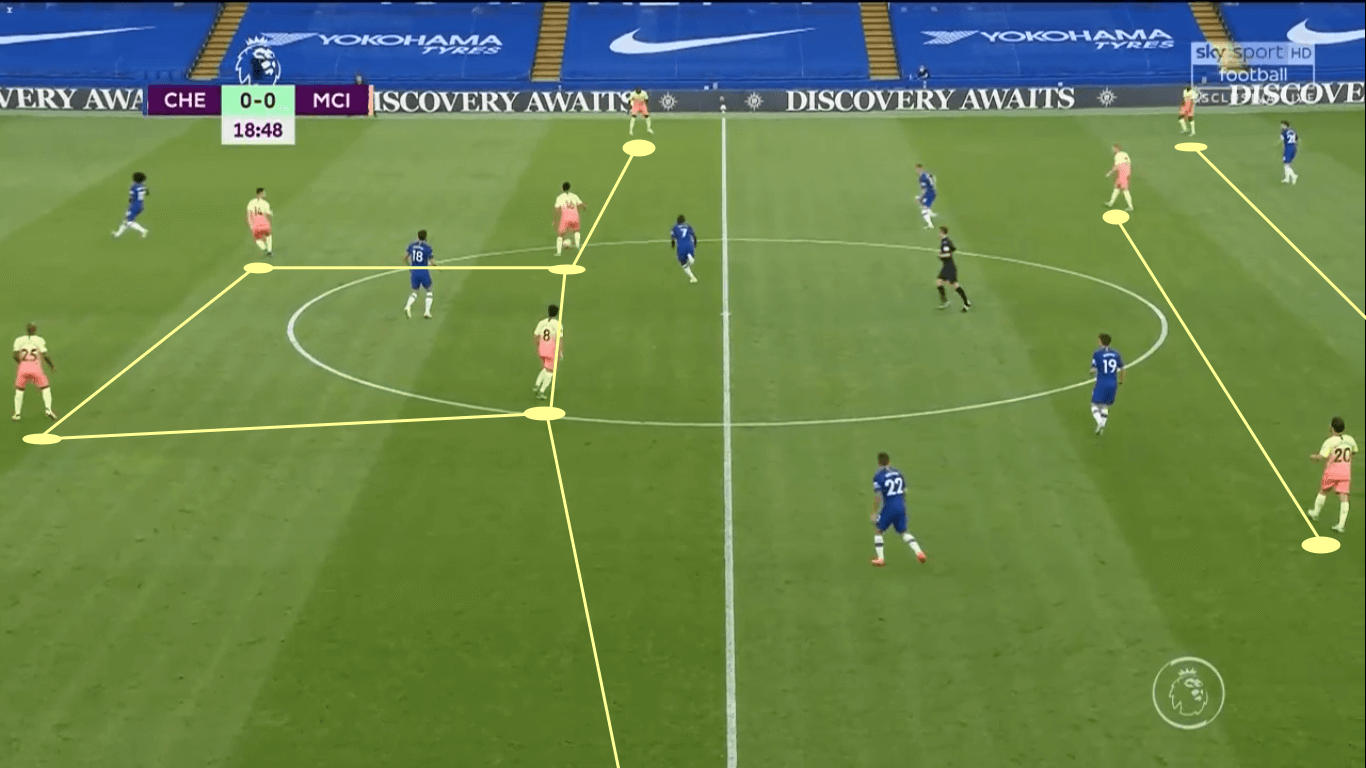
Even though Zidane will have a plan for his middle block approach, it’s that high press that will cause issues for City. Over the course of the season, Zidane has shown us that the high press and counterpress has two objectives. The first is simple, recover the ball. However, that comes with nuance. The attempted recovery should never come with the high, even moderate, risk of the opposition’s progression. With that in mind, the second objective is to force the opposition backwards if the attempt at recovery is too risky.
We saw these principles at play in the first leg too. The image below is the start of a sequence. City has an open possession and is looking to break lines, but those more advanced targets are unavailable.
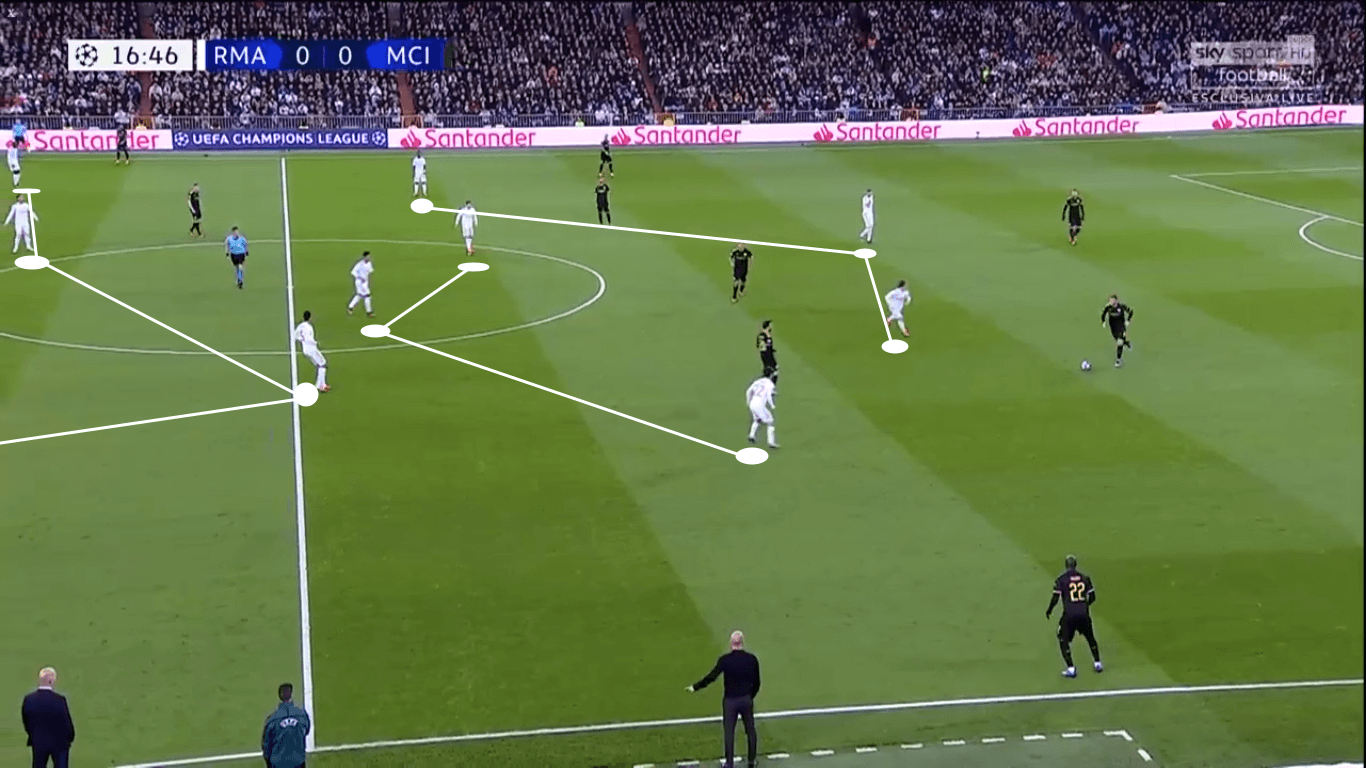
Rather than forcing a poor pass forward, City played negative and conceded some ground. Then, with more space between the lines, De Bruyne made his checking run. Ramos was right behind him, forcing De Bruyne to play negative. City tried to play forward but dropping as many players back as they did to simply keep possession made it impossible to connect with higher targets.
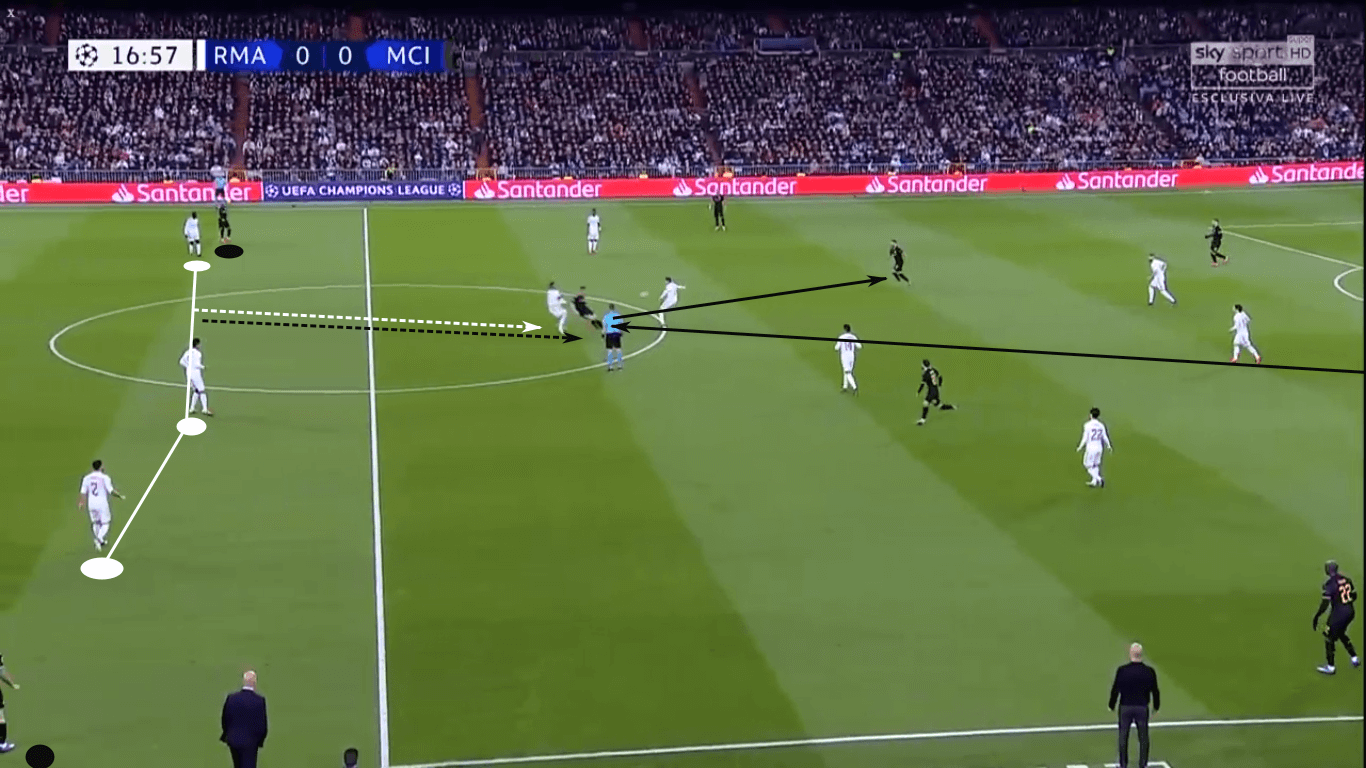
The example below shows what that man-marking in the high press looks like when the keeper is in possession. As you can see, all short and intermediate options are accounted for, leading to one of many unsuccessful long distributions from Ederson. With the shorter City forwards engaging in aerial duels with Real Madrid’s backline, there are no bonus points for guessing the favourite in those duels. Notice the depth of his positioning.
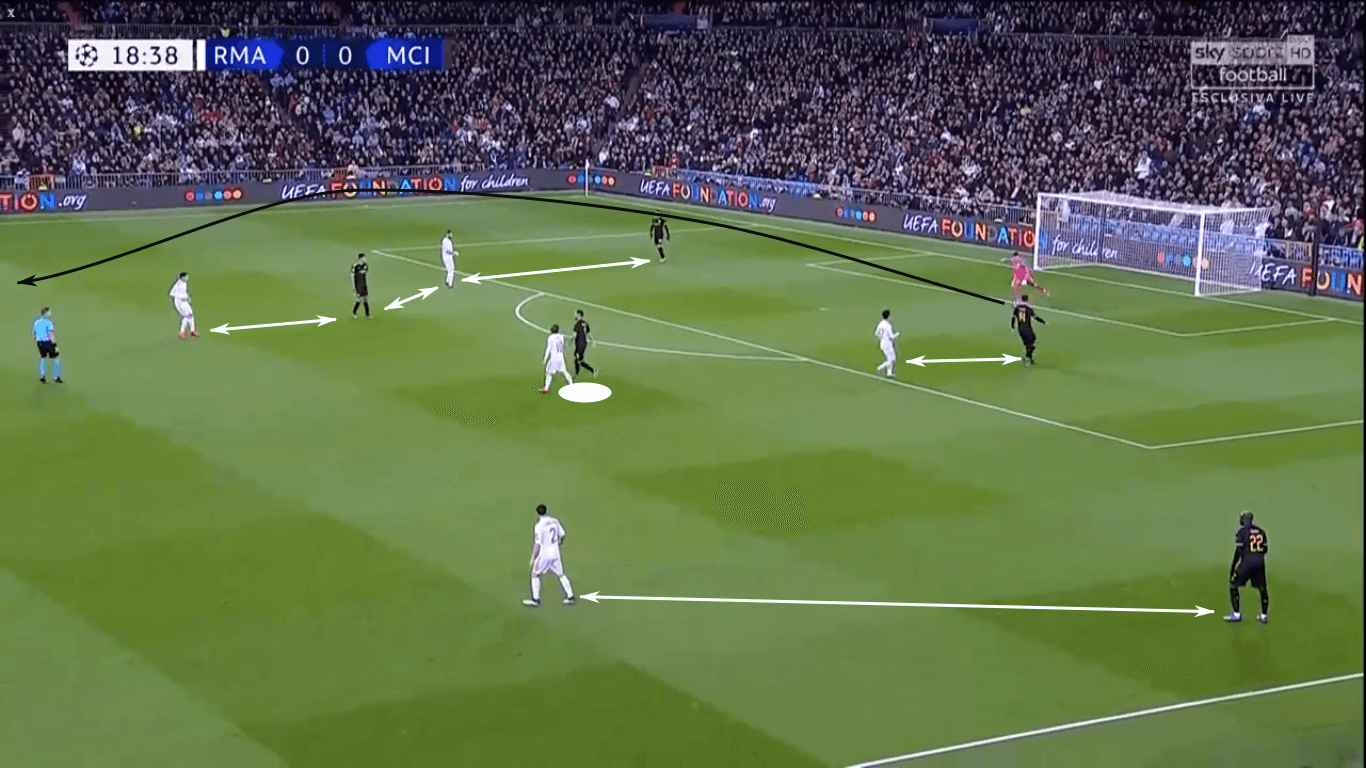
The one area of concern is covering depth if the Manchester City defenders are the ones playing forward. As you see in the image below, one of City’s best opportunities came when they played over Ramos onto the foot of Mahrez.
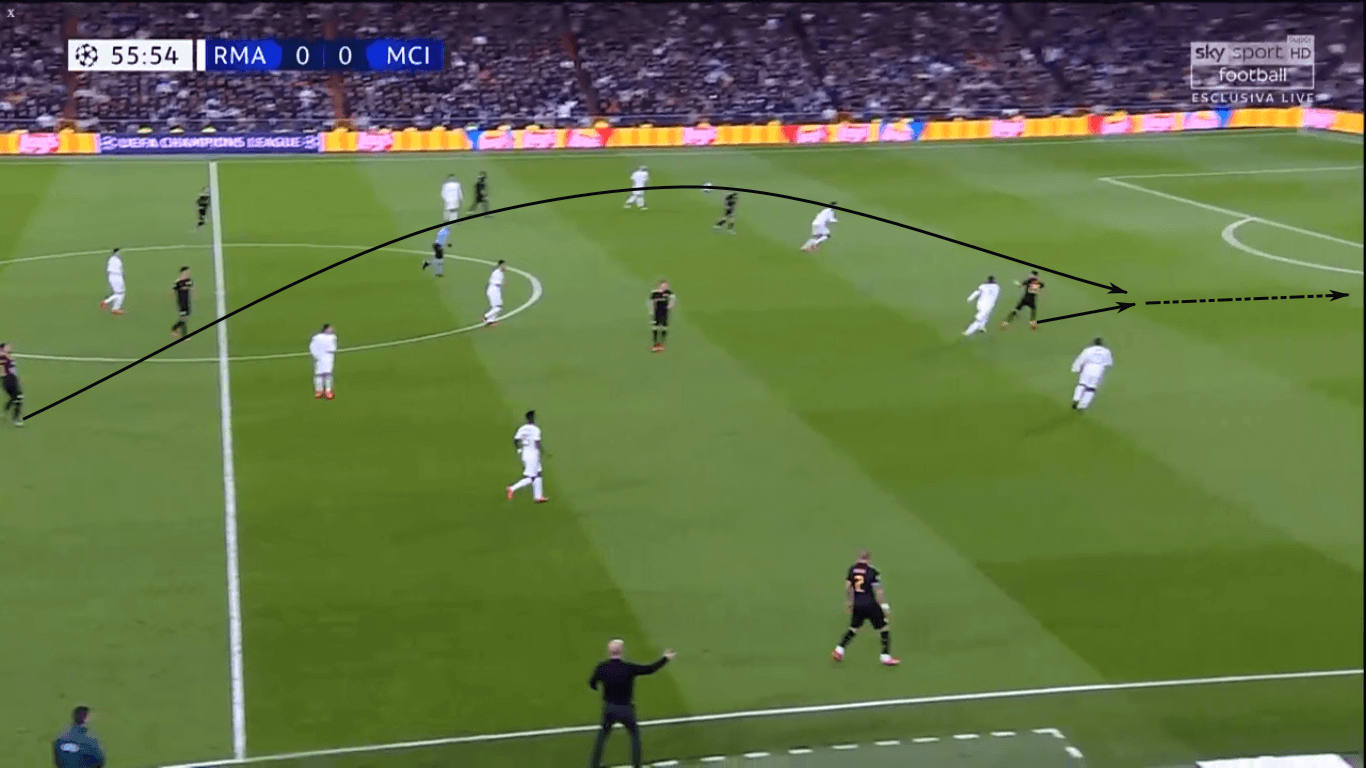
Addressing the elephant in the room, Ramos will watch from the stands, replaced by Militão. While the Brazilian doesn’t have the knack to step into the midfield and contest balls played between the lines, he should excel in these types of situations due to his more cautious approach and freakish athleticism. Losing Ramos is a big knock to controlling the space between the lines, a vital part of this matchup, but the combination of high press and low block defending will suit Militão well, especially when lined up with an intelligent cover defender like Varane.
Deny entry to and final passes from the half space
Speaking of the low block, let’s finish the article with that topic. When defending against City, they frequently look for wide superiorities that lead into final passes from the half spaces. As the top attacking side in all of Europe, they’ll incredibly dangerous when they gain access to the half space regions of the box. If it’s De Bruyne on the ball, say your prayers because you’re at his mercy.
Within that double pivot system, City will frequently enter the final third with the forwards and De Bruyne attacking the half spaces in pairs while the outside-backs patrol the wings.
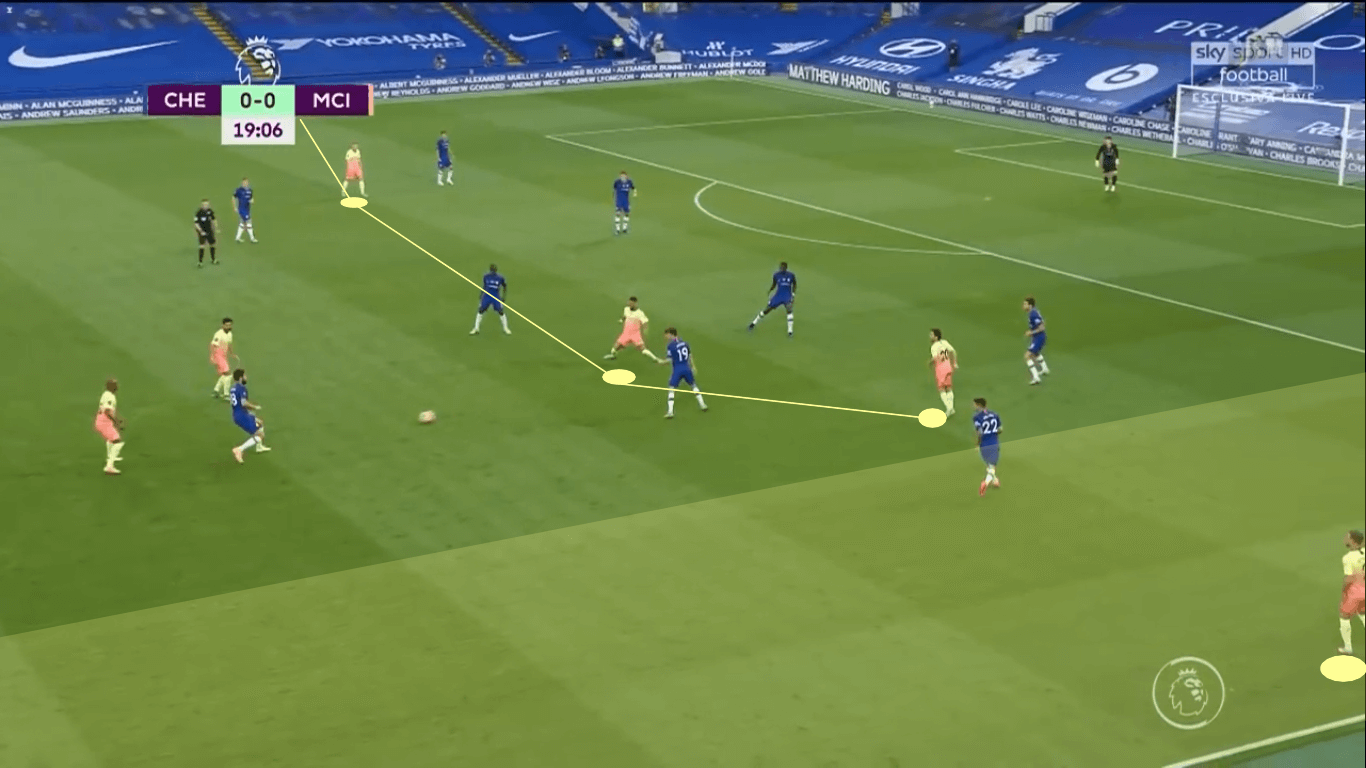
To some extent, Los Blancos should play into that tactic. Real Madrid must deny space centrally, forcing City to play in the wings. Once the ball arrives, Manchester City will often look for numerical equality. If they have a 3v3, they will look to play one of those three players behind the line and into the half space.
Even though he’s dangerous wherever he has the ball, limiting KDB’s options is easier on the wings than from the central channel. In the first leg, Real Madrid nearly conceded mid-way through the first half when De Bruyne split Varane and Carvajal. If not for a poor strike and quality save from Courtois, Madrid would have gifted a goal early.
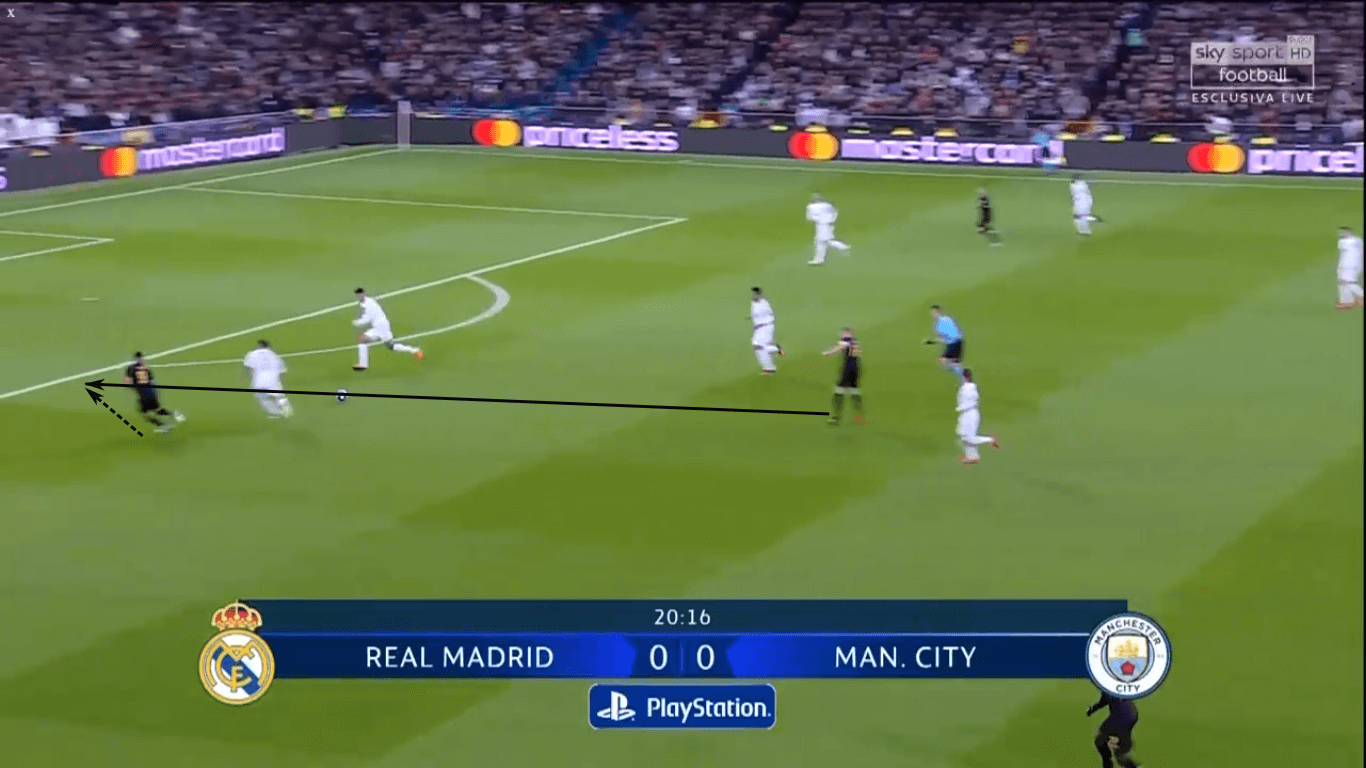
So, while pushing the City attack into the wings is preferred, Madrid must show better pressure, tackling and patience to block crosses. You’ll recall the defence on the tying goal was absolutely dreadful. Three players surrounded KDB, two others offered coverage, Mendy misread the cross and Ramos was outjumped by Jesus.
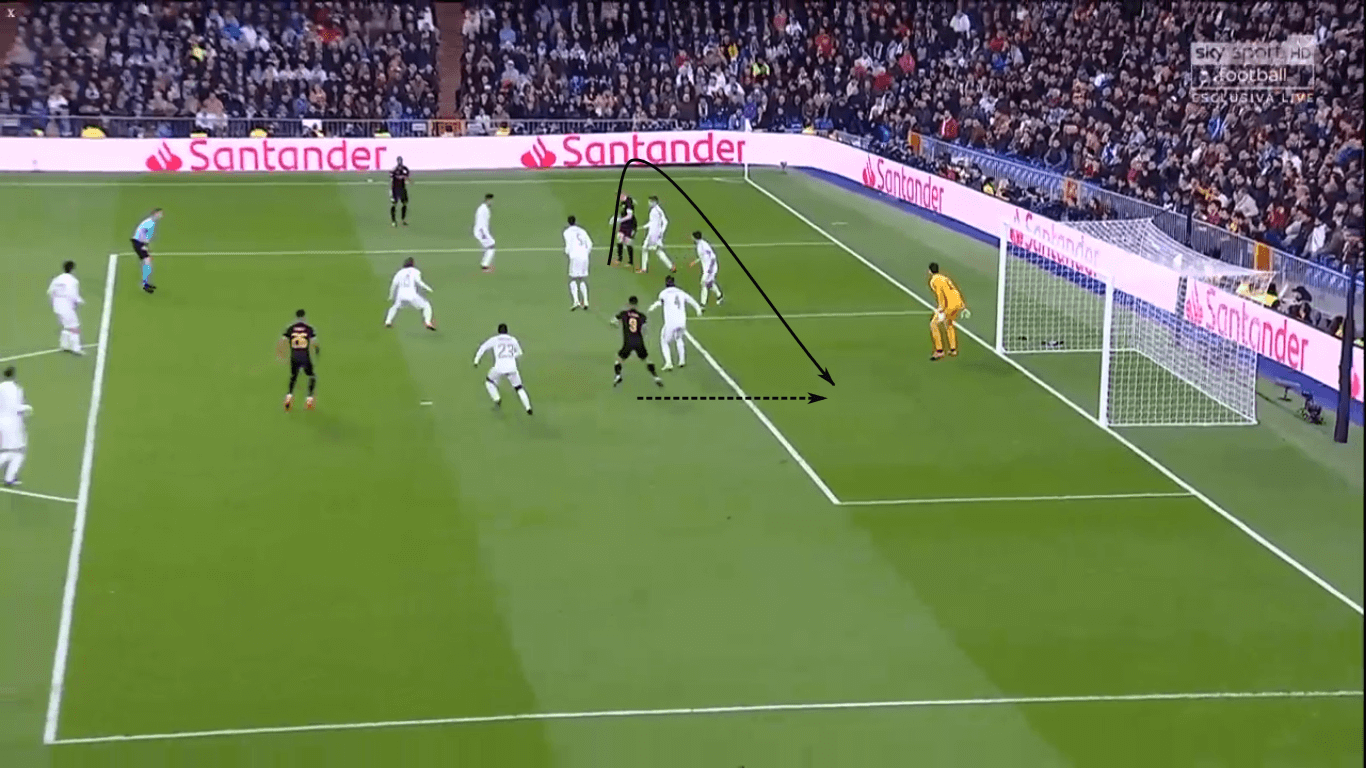
Among the many issues on the play, it’s the horrendous pressure, really the total lack of it despite numbers near the ball, that led to the goal. Real Madrid can’t afford this type of mental lapse in the match. Though they can definitely put a couple of goals past City, their leeway in this match is minimal. They can allow one goal and still make it to extra time, but two City goals will require four from Madrid for them to advance.
Having Militão’s heading ability and length will help as the side defends in the low block, but a proactive approach that denies those entries into the half spaces in the box is key.
Conclusion
With the heavy favourite tag comes the heavy burden of closing out the tie. City and Pep have long struggled against Europe’s elite in the knockout stages. The psychological weight on the City players is massive. If Real Madrid can grab a first-half goal and head into halftime with a lead, Manchester City’s mettle will really be tested in the second half. Seeing as this isn’t a team with much UEFA Champions League success, that despite the record-breaking spending sprees, it’s the La Liga champions who have the mental edge.
To be fair, Real Madrid still have it all to do. While the draw is not beyond them, they will have to suffer for a minimum of 90 minutes. Despite the odds stacked heavily against them, City’s Champions League history, Zidane’s ability to get the best out of his side and the champion’s mindset he brings to his squads make Madrid an alluring pick. We’ve seen crazier comebacks in the Champions League, so I’m going to predict that Pep over-thinks it with his lineup and tactical tinkering while Zidane’s side plays freely to a 3-1 win in the match, 4-3 win in the tie.



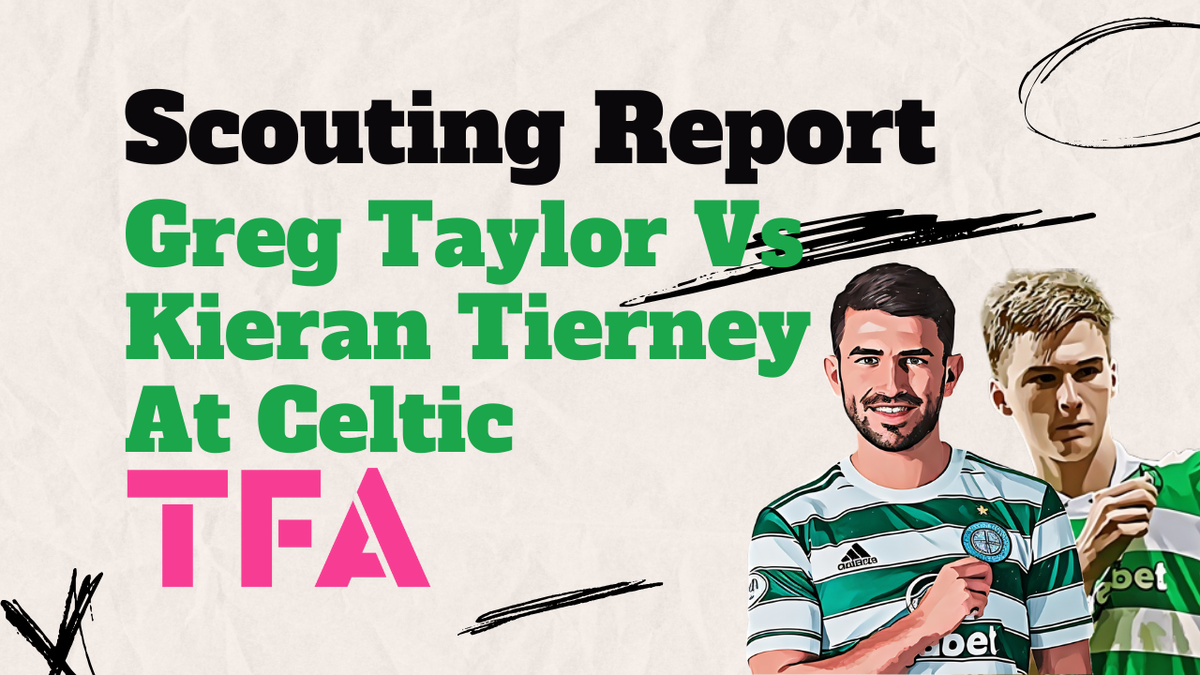
Comments